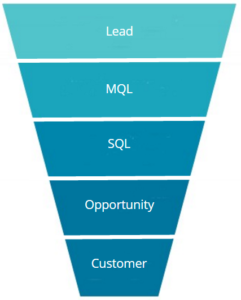Written By:
Tim Stobierski
For your sales and marketing efforts to be truly effective, you’re going to have to put in the hard work of aligning your sales and marketing teams. A big part of this process is creating a shared set of definitions that both teams can use in their day-to-day activities.
One of the most important terms for your team to define is “Marketing Qualified Lead,” or (MQL), as this definition will directly impact who your marketing team prioritizes in its outreach.
Free eBook: The Definitive Guide to Selling Better and Faster
What Is a Marketing Qualified Lead (MQL)?
Put in simple terms, a marketing qualified lead is a lead that is more likely to become a customer compared to other leads, based on analytics and lead intelligence. A marketing qualified lead is a lead that is considered “sales-ready,” and warrants targeted outreach from your sales team.
Identifying your marketing qualified leads is the first step in narrowing your sales funnel; without them, you wouldn’t know whom to target your outreach towards, which would lead to a.) a lot of wasted time and effort on the part of your marketing team and b.) low-quality leads being passed along to your sales team.

How to Create a Definition for Your Marketing Qualified Leads
What defines a marketing qualified lead can vary greatly from company to company and from industry to industry, which is why it’s so important for you to spend the time creating your own definition for the term.
1. First define your ideal buyer profile.
In large part, this definition will depend on your ideal buyer profile, which means that to define a marketing qualified lead you must first define your ideal buyer.
To create a clear picture of who your ideal buyer is, you must first ask yourself questions about what type of person is most likely to purchase your product or service. These questions will vary depending on whether you are a B2B company or a B2C company, but here is an example of some questions that a B2B business should ask while creating their ideal buyer profile:
- Are companies within certain industries more or less likely to purchase and benefit from your product or service?
- Are companies within certain geographic locations more or less likely to become customers?
- Would companies of a certain size (based on the number of employees, revenue, customers, or some other metric) benefit from your product in ways that companies of other sizes might not?
- Does your product or service target a certain demographic, and if so, what is this demographic?
This exercise will help you create a brief outline of what your ideal buyer looks like so that your sales and marketing teams have an easier time whittling down the funnel and identifying the correct leads.
2. Identify actions that indicate interest in your company.
Now that you know what your ideal buyer looks like, you can track them when they visit your company’s website and interact with your content. Depending on the types of actions that they take, you can gauge how interested they may be in your product or service.
Differentiating Marketing Qualified Leads from Sales Qualified Leads
Actions that may indicate the level of interest typical of a marketing qualified lead may include things the following:
- Visiting your website multiple times over the course of a day or week, or spending a lot of time on your website during a single visit
- Viewing a pricing page
- Viewing a page that outlines your process
- Explicitly requesting a consultation or booking a meeting through your website
Sales Qualified Leads (SQLs) differ from marketing qualified leads in that they have been directly qualified by a member of your sales team as someone who a.) fits the right criteria as a qualified lead, and b.) the sales rep feels there is a good chance they will become a real opportunity for the business.
While sales teams should prioritize qualifying MQLs first, they can also generate their own leads directly through targeted outreach and prospecting activities. In this scenario, a lead may become a SQL first without ever passing through marketing’s hands.
3. Revisit your criteria regularly.
Even if you are extremely thorough and thoughtful in establishing definitions for an MQL, chances are you won’t get it exactly right in the first, or even second, and third attempt. Definitions require regular review and refinement so that you and your team can continuously improve their focus and effectiveness.
Once you’ve established your funnel definitions, set a review meeting 90 days out to see how things are performing. With input from both your sales and marketing teams, you’ll want to discuss the following:
- What has the conversion rate from MQL to SQL been?
- Does the sales team feel leads have been qualified, or do they complain of “junk leads?”
- What can we learn about those MQLs who eventually became opportunities or customers? Are there certain common characteristics that should be put into the MQL definition?
The Bottom Line
Establishing definitions for key stages in your funnel is a great step in establishing greater collaboration and trust between your sales and marketing teams, but remember that the journey is a marathon, not a sprint. With continued discussions and collaboration you’ll create a laser focus that will give your organization the competitive advantage and accelerate revenue growth for years to come.






